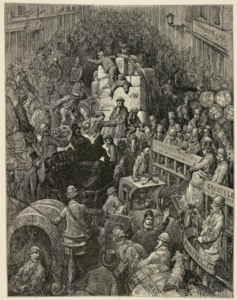Reputation in Pride and Prejudice
Although this was only my first time reading Pride and Prejudice, I can honestly say it has been added to my list of favorites! I somehow have managed to avoid all of the movies and the novel until this point in my life, but I am glad I finally read it! As illustrated by some of my peers’ blog posts, Jane Austen tackles many different aspects of the expectations placed upon women in the 1800’s. One of these reoccurring themes in Pride and Prejudice that greatly impacts Elizabeth as well as the other women around her is the presence, emphasis, and importance of a woman’s reputation.
It is absolutely no secret that women played a much different role in society in this time period than they do today. Although expectations and reputations do still catch up with women nowadays, it was even more important in the time of the novel for women to remain inside their respective roles. Breaking societal norms could entirely make or break a woman’s chance of participating important things such as marriage, and it could bring shame to the entire family. Never marrying would forever burden the family financially and shame could ruin every aspect of their lives. Reputation in terms of social class is also important for marriage prospects. By marrying someone with more money, the reputation of the woman, as well as her family, would increase. But with a poor reputation, this would be impossible to achieve, and the woman’s social class would remain the same or even fall.
The strong impact of a woman’s reputation is illustrated through Lydia’s decision to go with Wickham. When Lydia elopes and lives with Wickham out of wedlock, Austen emphasizes how catastrophic this is for not only Lydia but as well as the other Bennet sisters and the entire family. Elizabeth condemns Lydia’s choice, and she goes as far as to say that “she is lost forever” if she does not marry Wickham. Jane writes to Elizabeth, “Imprudent as a marriage between Mr. Wickham and our poor Lydia would be, we are now anxious to be assured it has taken place, for there is but too much reason to fear they are not gone to Scotland.” Jane wishes for the wedding because it looks a lot worse for Lydia and Wickham to run off unmarried than it does for them to run off married. Jane is conscious of how this decision will impact her and Elizabeth’s futures if the marriage has not happened. By not marrying Wickham and living with him, Lydia challenges social norms, but in a straightforward manner that is not accepted by society at all. It is fine for Elizabeth to challenge female expectations in little ways such as dirtying her skirt or being vocal situations where women normally would be silent, but Lydia’s decision has the potential to create a huge mark on the family reputation. This may not seem like a big deal from today’s viewpoint, but this decision could have pulled the entire family down. A woman truly was as valued as her reputation would allow, and Austen illustrates the weight reputation played on women perfectly. If Darcy had not paid Wickham the money for the wedding, Elizabeth would have been plagued by her sister’s decision, unable to marry well due to the shame it would bring, and the novel would probably have an entirely different ending.
